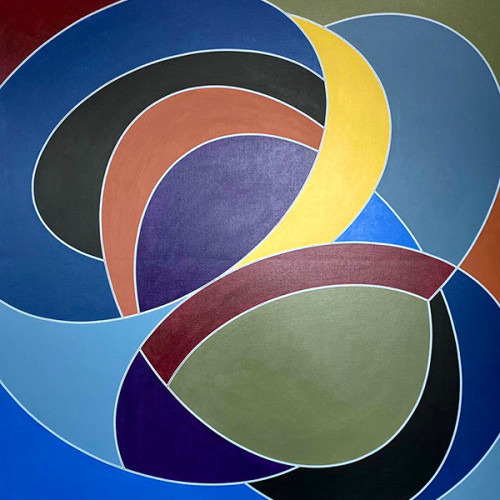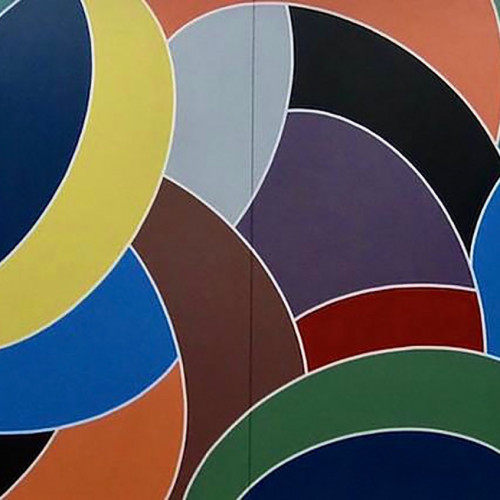Corey Postiglione
The esteemed Chicago painter Corey Postiglione uses semiotic abstraction in his work to portray themes and metaphorical subjects that include labyrinths, mazes, and the ancient symbol of the Ouroboros. Originating in ancient Egyptian iconography, the classical symbol of the Ouroboros depicts a snake in the act of eating its own tail, signifying infinity or the cycle of birth, death, and rebirth. A champion of geometric abstraction, Postiglione uses line to depict a labyrinth of chains, circles, and ovid shapes nesting inside one another. The labyrinth in his paintings signifies a rite of passage or the passage from a centered self to a decentered self. The interlocking connectedness and disconnectedness relate back to the entanglement and interconnection of those navigating a global pandemic.
Postiglione applies an austere technique to depict hard-edged geometric patterns and shapes in his canvas paintings Baroque Tango #2 and Tango Interlude #25, which deliver harmonious color schemes distributed evenly between warm and cool hues. His paintings reference late Modernism through post-painterly abstraction and an emphasis on shape, color, and composition. The result of his concentrated efforts is geometric patterns executed in elegant lines that dance across the flat canvas surface.
еЏ—дєєе°Љж•¬зљ„иЉќеЉ е“Ґз”»е®¶ Corey Postiglione ењЁд»–зљ„дЅње“ЃдёдЅїз”Ёз¬¦еЏ·е¦жЉЅи±ЎжќҐжЏЏз»дё»йўе’Њйљђе–»дё»йўпјЊеЊ…括迷宫、迷宫和衔尾蛇的古老象征。衔尾蛇的经典符号起源于古埃及的肖像画,描з»дє†дёЂжќЎеђѓи‡Єе·±е°ѕе·ґзљ„и›‡пјЊи±ЎеѕЃзќЂж— й™ђж€–з”џгЂЃж»е’Њй‡Ќз”џзљ„еѕЄзЋЇгЂ‚дЅњдёєе‡ дЅ•жЉЅи±Ўзљ„ж‹ҐжЉ¤иЂ…пјЊPostiglione дЅїз”ЁзєїжќЎжЏЏз»иї·е®«и€¬зљ„链条、圆形和卵形相互嵌套的形状。他画作дёзљ„иї·е®«и±ЎеѕЃзќЂдёЂз§ЌйЂљиї‡д»ЄејЏж€–д»ЋдёЂдёЄдёеїѓзљ„自我到一个去дёеїѓзљ„自我的转еЏгЂ‚环环相扣的连通性和脱节与那些在全球大流行дёи€ЄиЎЊзљ„дєєзљ„зє зј е’Њз›ёдє’иЃ”зі»жњ‰е…ігЂ‚ Postiglione 在他的油画《巴洛克探戈#2гЂ‹е’ЊгЂЉжЋўж€€жЏ’ж›І#25гЂ‹дёеє”з”Ёдє†дёЂз§Ќжњґзґ зљ„жЉЂжњЇжќҐжЏЏз»зЎ¬иѕ№е‡ 何图案和形状,这两种颜色在暖色调和冷色调之间均匀分布。他的画作通过з»з”»еђЋзљ„抽象和对形状、颜色和构图的强调来参考晚期现代主义。他集дёеЉЄеЉ›зљ„з»“жћњжЇењЁе№іеќ¦зљ„画布表面上以дјй›…зљ„зєїжќЎж‰§иЎЊзљ„е‡ дЅ•е›ѕжЎ€гЂ‚


